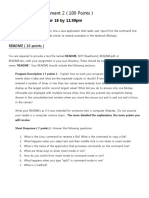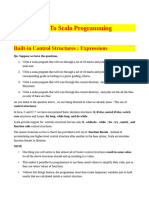Lab 5
Lab 5
Uploaded by
mhasanjafryCopyright:
Available Formats
Lab 5
Lab 5
Uploaded by
mhasanjafryOriginal Description:
Copyright
Available Formats
Share this document
Did you find this document useful?
Is this content inappropriate?
Copyright:
Available Formats
Lab 5
Lab 5
Uploaded by
mhasanjafryCopyright:
Available Formats
Lab 5 CS 455
1 of 4
http://scf.usc.edu/~csci455/curr/labs/lab5/lab5.html
CS 455 Lab 5: Invariants/Processing lines
Fall 2015 [Bono]
Goals and Background
In this lab you are going to do a few tasks that will help you with programming assignment 2 (pa2), some
written, and some coding. They involve three different issues: (1) assert statements (2 & 3) representation
invariants and (4) reading a bunch of numbers on one line. Because the different parts are about different
issues, the readings and reference material links below mention what exercise they pertain to.
A note about lab partnerships: This is a reminder that pa2 is to be done individually. In this lab you may
still work with a partner, because for the most part you will not be writing code that you will directly be using
in pa2. However, if by your lab section time you have already done more on your own on pa2 than what is
asked for in Ex 3 and/or 4 here, you should work on your own for this lab, and you you may use your pa2
solution-in-progress to satisfy those exercises. Similarly, for students not in that situation, once you complete
this lab with your partner, if you wanted to go further working on pa2 during lab, you would do that
individually rather than with your lab partner. If you are working with a partner, remember to switch roles
with your partner from what you were last time. For more information on lab partnerships, see Lab 2.
Prelab
Before the lab read over the whole programming assignment description (linked in the next section), paying
particular attention to the subsections with their own links below.
Reading and reference material
Programming assignment 2 (exercise 1 - 4) and these specific parts in particular:
Bulgarian solitaire game (exercise 2)
SolitaireBoard: representation/implementation (exercises 2 & 3)
Representation invariants (exercises 1, 2 & 3)
Converting a String into an array of numbers (exercise 4)
Horstmann, Special Topic 11.5 covers assert statements (exercise 1)
Horstmann, Section 11.2.5 Scanning a String (exercise 4)
Horstmann, Section 7.7.4 Wrappers and Auto-boxing (exercise 4)
CS 455 lectures this week: preconditions, assert statements (exercise 1)
CS 455 lectures this week: invariants, more with assert statements (exercise 3)
Exercise 1 (1 checkoff point)
The code for a Term class can be found in the lab directory:
~csci455/labs/lab5/Term.java
10/6/2015 6:38 PM
Lab 5 CS 455
2 of 4
http://scf.usc.edu/~csci455/curr/labs/lab5/lab5.html
It stores the coefficient and exponent that make up a single term in a polynomial. It has a precondition on one
of it constructors. The constructor uses an assert statement to check the precondition. Write a little test
program, AssertTester.java, to force the assertion to fail. Your test program should also include calls to the
constructor that don't make the assertion fail. The purpose of this is to make sure you know how turn on
assertion checking, and to see what happens when one fails.
Run the program two times, once with and once without assertion-checking enabled. To enable assertions you
use the -ea flag with java (the run-time system); otherwise, assertions are ignored. You do not have to
compile the code any special way.
Question 1.1 Besides the name of the method called, what information in the exception error message can
help lead you to the exact location of the failure?
To get checked off show the TA the code running with the assertion failure. DEN students should put a copy
of the message they get when the assertion fails in their README file.
Exercise 2 (1 checkoff point)
The first question is to demonstrate your understanding of how Bulgarian Solitaire works. The game is
described in the assignment section of the pa2 writeup.
Question 2.1 On paper (or in README) complete the following example of a Bulgarian Solitaire game (the
same example that's in the assignment description. Show what would be on the board after each round
(number each round). We're starting it out for you:
initial: 20 5 1 9 10
after round 1: 19 4 8 9 5
The rest of this exercise concerns representation invariants. You will need to have read the section on
SolitaireBoard: representation/implementation in pa2 before doing this part.
Question 2.2 On paper (or in README) write down the variable declarations for the instance variable(s) for
your SolitaireBoard.
Question 2.3 On paper (or in README) for each of the following, either (1) show a diagram of what the
corresponding SolitaireBoard will look like internally, including array indices, values, capacity and size (you
don't have to show every last element, but may use ". . ." in places). To say it another way, what will be the
internal representation inside of a SolitaireBoard object for that board configuration. Or, (2) if that sequence
is not a legal board configuration, say so:
1. 20 5 1 9 10
2. 45 1
3. 45
4. 1 1 1 1 1
5. 1 1 1 . . . 1 [repeated 45 times]
6. 100 -55
7. 1 0 44
10/6/2015 6:38 PM
Lab 5 CS 455
3 of 4
http://scf.usc.edu/~csci455/curr/labs/lab5/lab5.html
Save your answer, because you may want to use some of the above as some of the test cases for your
BulgarianSolitaireSimulator.java. later.
Exercise 3 (1 checkoff point)
You should read the pa2 section on Representation invariants before doing this part. The textbook doesn't
discuss representation invariants, but we discussed the concept and went through a few examples of
representation invariants in lecture this week.
Write the representation invariant for the SolitaireBoard class representation we are using. This would take
the form of a list of conditions that must be true about our representation for the SolitaireBoard methods to
work properly when we implement them (like with preconditions, you don't include things that are checked
by the compiler, such as the type of an instance variable). We would assume this list is "and"-ed together, but
you could also put in some "or" conditions by stating that explicitly. You want the condition to be as specific
as possible.
All of your answers that you declared as legal from Question 2.3 should satisfy the invariant you write.
Save your answer, because you will be working more with this invariant for pa2, in particular, putting it in a
comment in your code, and writing a method to test it.
Exercise 4 (1 checkoff point)
Part of pa2 involves your reading an indeterminate number of numeric values from one line of input (and the
end of the line indicates the user is done entering the list of values). The code you have to write for the
assignment itself will be a little different, but here we're going to write a similar test program to make sure we
can get this type of code to work.
The section about this in the assignment gives more information about how to write code to do this.
Here we're going to write a little test program to test out the technique. Call this program ReadTester.java.
Structure it as an infinite loop (so you'll have to exit the program with ctrl-c). For each loop iteration, print a
prompt for the user, and then read all the data from the line into an ArrayList, and then print out the whole
ArrayList. (Note: in pa2 we won't be using an arraylist.) Running it might look something like this (user input
shown in bold):
Enter a space separated list of numbers: 1 3 5
The numbers were: [1, 3, 5]
Enter a space separated list of numbers:
The numbers were: []
Enter a space separated list of numbers: 7
The numbers were: [7]
Unlike the input for pa2, for this lab you are not required to error-check that all the values entered were
integers. Some hints:
Remember that if you want an ArrayList of a primitive type element, you have to use a wrapper class.
E.g., you define ArrayList<Integer> (not int). Java autoboxing takes care of wrapping and
unwrapping your ints (this was discussed in more detail in section 7.7.4 of the textbook).
Many Java classes have a toString method that converts them to a String form. When you put such an
10/6/2015 6:38 PM
Lab 5 CS 455
4 of 4
http://scf.usc.edu/~csci455/curr/labs/lab5/lab5.html
object in a println statement, if toString is defined for that class it automatically gets called so the
String gets printed. (Usually in a format suitable for debugging print statements.) So for example, the
following line of code will print a whole ArrayList:
ArrayList<...> myArrList;
...
System.out.println(myArrList);
(If you want to know more about toString see section 9.5.1 in the textbook -- you don't need to know
that material to do this lab problem, however.)
To get the checkoff point, show the TA your source code, and show the program running on various numbers
of ints on the line with varying amounts of spaces before, between and after them, and including a case where
there are no ints entered on the line (i.e., just a "return" -- the second case shown above).
Checkoff for DEN students
Submit the files AssertTester.java, ReadTester.java, and README using the following command:
submit -user csci455 -tag lab5 AssertTester.java ReadTester.java README
The University of Southern California does not screen or control the content on this website and thus does not guarantee the accuracy,
integrity, or quality of such content. All content on this website is provided by and is the sole responsibility of the person from which such
content originated, and such content does not necessarily reflect the opinions of the University administration or the Board of Trustees
10/6/2015 6:38 PM
You might also like
- Data Structures NYU Midterm 2015 SolutionDocument6 pagesData Structures NYU Midterm 2015 SolutionjdNo ratings yet
- Lab 2 - Basic Programming in Java-BESE-10Document9 pagesLab 2 - Basic Programming in Java-BESE-10Waseem AbbasNo ratings yet
- Adaptive Quad ProofDocument6 pagesAdaptive Quad ProofEtta AmareshNo ratings yet
- DBMS CHO - StudentDocument4 pagesDBMS CHO - StudentgirishNo ratings yet
- Lab 3Document6 pagesLab 3mhasanjafryNo ratings yet
- Lab 2Document6 pagesLab 2mhasanjafryNo ratings yet
- Assignment: 7: Due: Language Level: Allowed Recursion: Files To Submit: Warmup Exercises: Practise ExercisesDocument6 pagesAssignment: 7: Due: Language Level: Allowed Recursion: Files To Submit: Warmup Exercises: Practise ExercisesYanling LinNo ratings yet
- Test-Driven APIs With Laravel and Pest Sample ChapterDocument32 pagesTest-Driven APIs With Laravel and Pest Sample ChapterJendela KayuNo ratings yet
- Programming Assignment 1Document17 pagesProgramming Assignment 1Ankur KothariNo ratings yet
- Directions: For Information On EOF Refer To Question Bank #1, Part-A, Q4Document9 pagesDirections: For Information On EOF Refer To Question Bank #1, Part-A, Q4Abhishek ChawlaNo ratings yet
- CS2 Corrections 2019Document6 pagesCS2 Corrections 2019Githui KiunaNo ratings yet
- Lewis 409167 LabMan02Document27 pagesLewis 409167 LabMan02desireeibonNo ratings yet
- Programming-Assignment-1Document17 pagesProgramming-Assignment-1arul varmanNo ratings yet
- CSE 331 Final Exam 3/18/13Document14 pagesCSE 331 Final Exam 3/18/13Aijin JiangNo ratings yet
- ML Lab 01 Manual - Intro To PythonDocument9 pagesML Lab 01 Manual - Intro To Pythondodela6303No ratings yet
- Null Pointer AssignmentDocument10 pagesNull Pointer Assignmentibodduhjf100% (2)
- SYSC2006 Lab7Document3 pagesSYSC2006 Lab7diaansiddikyNo ratings yet
- Control Systems Lab 1Document8 pagesControl Systems Lab 1Patrick GoNo ratings yet
- CSE 425 Studio: Control Abstraction IIDocument2 pagesCSE 425 Studio: Control Abstraction IIAmna NoorNo ratings yet
- Java Programming 1Document22 pagesJava Programming 1r4nd0scilltrNo ratings yet
- Taller Laboratorios Módulo 4 PythonDocument11 pagesTaller Laboratorios Módulo 4 PythonSantiago RiveraNo ratings yet
- Questions TNP 2024 - 2Document16 pagesQuestions TNP 2024 - 2Amee VaghelaNo ratings yet
- Java ExamDocument3 pagesJava Exammdfire0No ratings yet
- Verilog FAQ's With AnswerDocument26 pagesVerilog FAQ's With Answerrishabh guptaNo ratings yet
- CO Project 2024 v8Document12 pagesCO Project 2024 v8pes 2018 GameNo ratings yet
- Week1 Basic Data StructuresDocument18 pagesWeek1 Basic Data Structuresshreyansh guptaNo ratings yet
- Assignment 1Document7 pagesAssignment 1Angel AngelNo ratings yet
- Toaz - Info Control Systems Lab 1 PRDocument8 pagesToaz - Info Control Systems Lab 1 PRrhydnar KimNo ratings yet
- File 30Document56 pagesFile 30Priya MishraNo ratings yet
- Programming Assignment 2 (100 Points) : Due: Thursday, October 16 by 11:59pmDocument10 pagesProgramming Assignment 2 (100 Points) : Due: Thursday, October 16 by 11:59pmallen xuNo ratings yet
- Programming Assignment 1: Basic Data StructuresDocument18 pagesProgramming Assignment 1: Basic Data StructuresDaniel SerranoNo ratings yet
- COMP2511 Lesson 1Document44 pagesCOMP2511 Lesson 1serachguruNo ratings yet
- Final Exam2016Document16 pagesFinal Exam2016Dodoy Leandro Frincillo CrebelloNo ratings yet
- A4Document5 pagesA4jonor21545No ratings yet
- 2) Difference Between Blocking and Non-Blocking? (Verilog Interview Questions That Is MostDocument39 pages2) Difference Between Blocking and Non-Blocking? (Verilog Interview Questions That Is MostRAGUL RAJ SNo ratings yet
- ICS4U Java BOOKLET 1 - Data StructuresDocument66 pagesICS4U Java BOOKLET 1 - Data StructuresjoeyNo ratings yet
- Verilog Interview Questions Part 1Document7 pagesVerilog Interview Questions Part 1radhakodirekka8732No ratings yet
- Introduction Data Science Programming Handout Set 1B1Document47 pagesIntroduction Data Science Programming Handout Set 1B1dinoda6464No ratings yet
- Data Structures Programming AssignmentDocument20 pagesData Structures Programming Assignmentmario kartNo ratings yet
- Activity 1Document10 pagesActivity 1Darryl Dave DitucalanNo ratings yet
- HW 2Document4 pagesHW 25qf59ptg2sNo ratings yet
- Assignment 3 PDFDocument5 pagesAssignment 3 PDFanon_929121264No ratings yet
- Java Basics - Java Programming TutorialDocument64 pagesJava Basics - Java Programming Tutorialrex tanongNo ratings yet
- CS36 Lab 5Document4 pagesCS36 Lab 5Syed ZaidiNo ratings yet
- Lab 02Document47 pagesLab 02acme bombNo ratings yet
- A453 - Controlled Assessment PreparationDocument8 pagesA453 - Controlled Assessment Preparationapi-253559971No ratings yet
- Ase Exam1718Document2 pagesAse Exam1718qwerNo ratings yet
- Verilog Interview Questions & AnswersDocument6 pagesVerilog Interview Questions & AnswersKrishna Saroja SankaNo ratings yet
- Aqa Comp1 W Ms Jun09Document35 pagesAqa Comp1 W Ms Jun09the1mike1manNo ratings yet
- Parallel SortDocument7 pagesParallel SortzololuxyNo ratings yet
- SYSC2006_Lab6 (1)Document6 pagesSYSC2006_Lab6 (1)diaansiddikyNo ratings yet
- Java QuestionsDocument9 pagesJava Questionsmyhealth632No ratings yet
- Java Programming Lab Manual-22PLC25C 2022-23Document27 pagesJava Programming Lab Manual-22PLC25C 2022-23Vish KNo ratings yet
- C PrimerDocument10 pagesC PrimerAbhishekLolageNo ratings yet
- CS3201 Assignment 4: Extended Prototype: 12pm. SubmissionDocument10 pagesCS3201 Assignment 4: Extended Prototype: 12pm. SubmissionNicholasLumNo ratings yet
- ML Lab 09 Manual - Introduction To Scikit LearnDocument6 pagesML Lab 09 Manual - Introduction To Scikit LearnALI HAIDERNo ratings yet
- Java Training Handout Arrays - Methods-StringsDocument29 pagesJava Training Handout Arrays - Methods-Stringsawanjiku156No ratings yet
- Advanced SAS Interview Questions You'll Most Likely Be AskedFrom EverandAdvanced SAS Interview Questions You'll Most Likely Be AskedNo ratings yet
- Good Habits for Great Coding: Improving Programming Skills with Examples in PythonFrom EverandGood Habits for Great Coding: Improving Programming Skills with Examples in PythonNo ratings yet
- IBM United States Software Announcement 217-282, Dated June 6, 2017Document9 pagesIBM United States Software Announcement 217-282, Dated June 6, 2017elias.ancares8635No ratings yet
- 1: Programs Involving Data Transfer Instructions: Example Result: Before Execution: After ExecutionDocument61 pages1: Programs Involving Data Transfer Instructions: Example Result: Before Execution: After ExecutionHertz SNo ratings yet
- Update Documentation P54X/En Ad/Kb4 Micom P543, P544, P545 & P546 (Ad) - 3Document1 pageUpdate Documentation P54X/En Ad/Kb4 Micom P543, P544, P545 & P546 (Ad) - 3karthikNo ratings yet
- HD Tune ProDocument2 pagesHD Tune ProSaima firdousNo ratings yet
- Tugas Bahasa Inggris IIDocument2 pagesTugas Bahasa Inggris IIselfiaNo ratings yet
- Informatica Interview Questions and AnswersDocument13 pagesInformatica Interview Questions and AnswersRammurthyNo ratings yet
- DBCC and SP CommandsDocument5 pagesDBCC and SP Commandssirisha715No ratings yet
- CTCI6 Preparation Map PDFDocument2 pagesCTCI6 Preparation Map PDFAnonymous PscapuNo ratings yet
- Aisee 3.4.3 User ManualDocument113 pagesAisee 3.4.3 User ManualTerry CarrollNo ratings yet
- Final Project SRS-HRMSDocument9 pagesFinal Project SRS-HRMSViraj Raiyani50% (2)
- Operations Research: Matrix Games in General CaseDocument14 pagesOperations Research: Matrix Games in General Casevuhquang01No ratings yet
- IoT Protocols OverviewDocument9 pagesIoT Protocols OverviewClint SmithNo ratings yet
- Multicore Question BankDocument5 pagesMulticore Question BankVenkatakrishnan NatchiappanNo ratings yet
- RGB Led, Active Buzzer and Creating A Led Chaser Using Arduino Uno R4Document41 pagesRGB Led, Active Buzzer and Creating A Led Chaser Using Arduino Uno R4Safrana KasimNo ratings yet
- Restore Files Encrypted Via RSA Encryption. Remove CryptoWall and Other Ransomware ManuallyDocument11 pagesRestore Files Encrypted Via RSA Encryption. Remove CryptoWall and Other Ransomware Manuallyمحمد صادق فؤاد شهابNo ratings yet
- Ipsec With Cisco AsaDocument10 pagesIpsec With Cisco AsaSai Kyaw HtikeNo ratings yet
- Performance Comparison of Simulated Annealing GA and ACO Applied To TSPDocument8 pagesPerformance Comparison of Simulated Annealing GA and ACO Applied To TSPSaurav AcharyaNo ratings yet
- Mcse 004Document241 pagesMcse 004AarzooNo ratings yet
- CSC 413 - Software Development 4. Object Oriented Design: 2/3/18 John RobertsDocument15 pagesCSC 413 - Software Development 4. Object Oriented Design: 2/3/18 John Robertseveswan2008No ratings yet
- Phantom 2Document14 pagesPhantom 2Nacho RoccaNo ratings yet
- Introduction To The SDLCDocument83 pagesIntroduction To The SDLCkalyanicNo ratings yet
- Lingo 11 Users ManualDocument712 pagesLingo 11 Users ManualahtramggNo ratings yet
- Transforming EER Diagrams Into Relations: Mapping Regular Entities To RelationsDocument28 pagesTransforming EER Diagrams Into Relations: Mapping Regular Entities To Relationsseerat fatimaNo ratings yet
- EasusUser GuideDocument37 pagesEasusUser GuidemnemedezNo ratings yet
- Creating A Cool Vintage Collage Design in Photoshop - PSDTUTSDocument17 pagesCreating A Cool Vintage Collage Design in Photoshop - PSDTUTStsara_t100% (1)
- Chapter 2Document20 pagesChapter 2Keven Joe SuicoNo ratings yet
- Drivers WikiDocument4 pagesDrivers WikiLucero HernandezNo ratings yet
- UtilitiesDocument334 pagesUtilitiesAnu AlagendranNo ratings yet

























































































